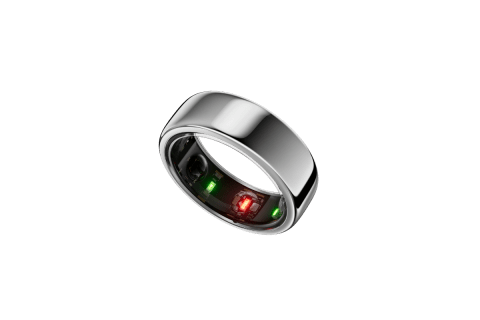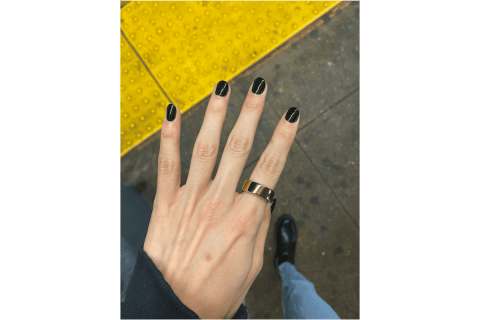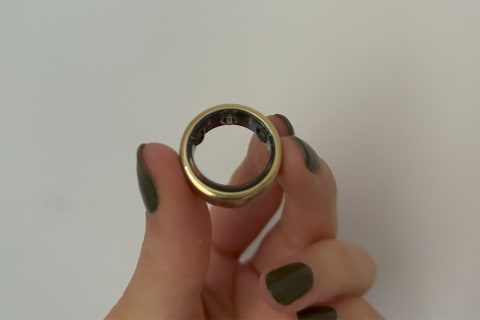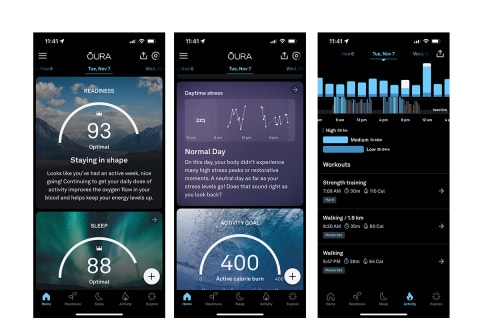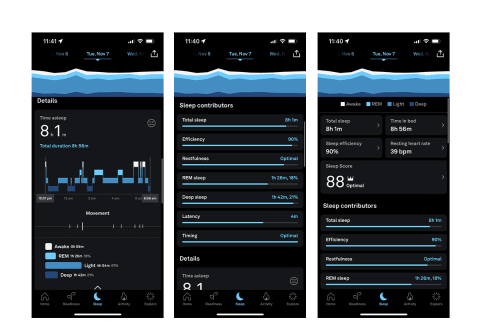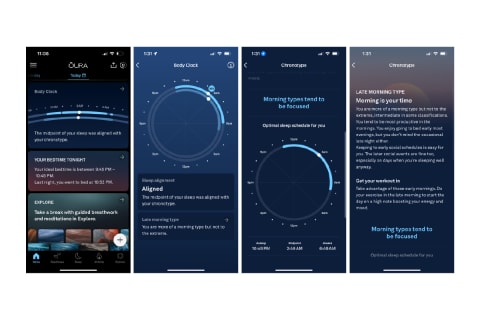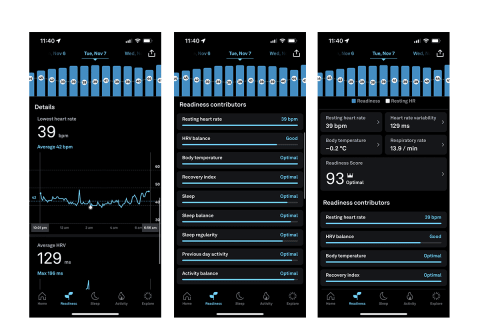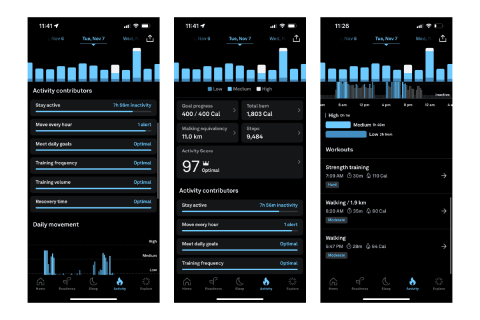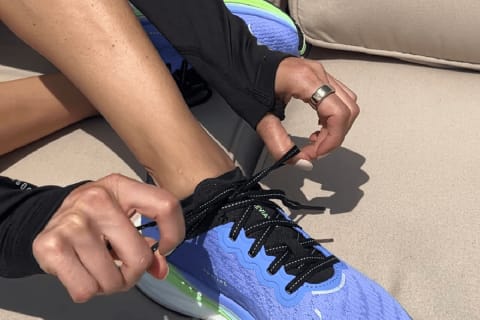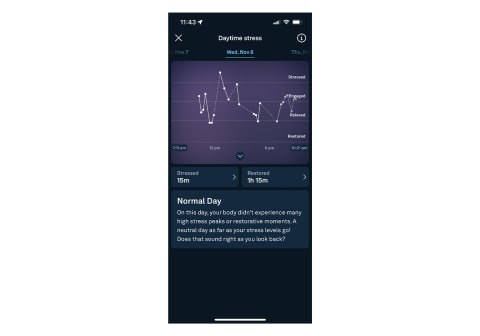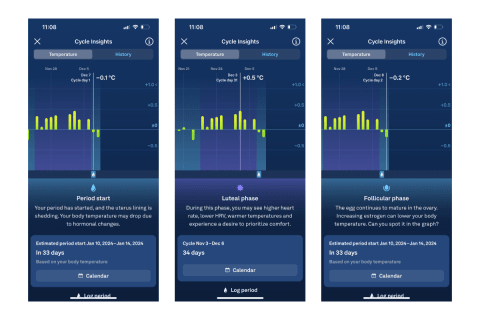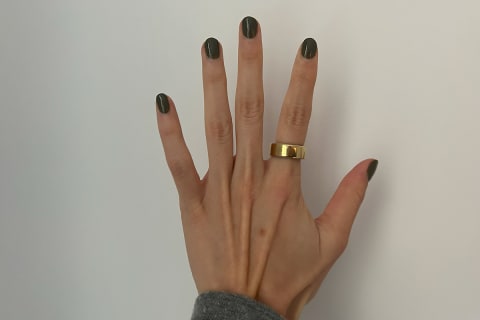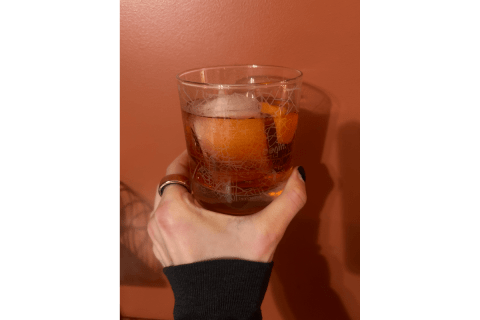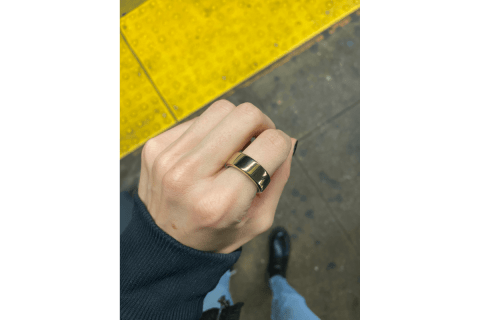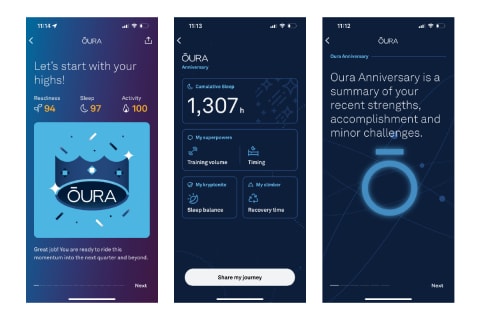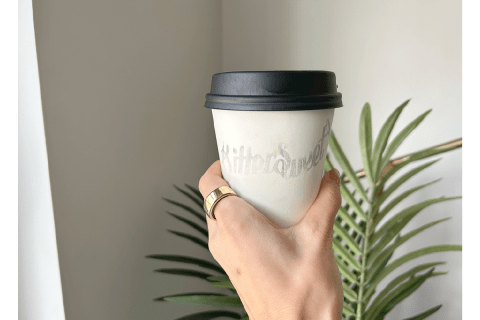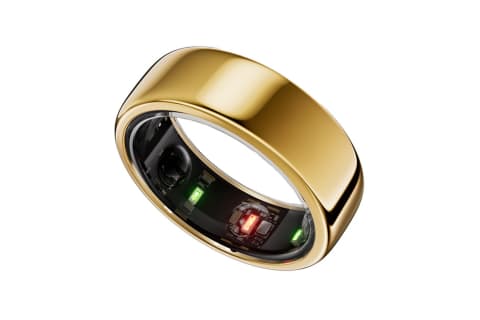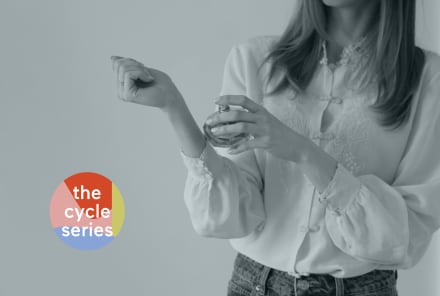Advertisement
Oura Ring Review: 7 Reasons We Love It (& What We'd Change)

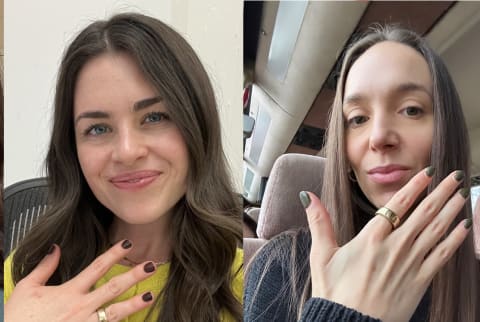
I never thought a piece of jewelry would lead to a complete overhaul of my health routine, but then again I'd never worn an Oura ring until last November.
One of the most coveted health trackers in the mindbodygreen office, the lightweight ring uses ultra-sensitive sensors to measure heart rate, blood oxygen levels, body temperature, and movement throughout the day.
The only reason it's not on every staffer's finger? Oura rings start at $299 with a $5.99 monthly subscription fee. Still at least eight of our health-enthusiast editors have caved on the tiny wearable, and we've spent 38 collective months testing out the tracker.
Aside from our executive editor, I've worn my Oura ring longer than anyone on the staff—here's my brutally honest take after 365+ days.
- Along with increasing my HRV and sleep score with the Oura Ring, I was able to use the Natural Cycles integration to regulate my menstrual cycle.
- I swear by the sleep and readiness scores to determine my health routine, but I think the activity tracking could be better.
- The Oura ring is the first wearable that I actually stuck with for over a year because it's so lightweight and comfortable (its weight is closer to plastic than metal).
- Select ring finishes show more wear and tear than others—like my gold ring. If you worry about scuffs, opt for the Stealth color.
- Oura rings can be easy to lose if they don't fit properly (just ask our health director Emma Loewe), so I recommend that you order the sizing kit.
- I found Oura rings are super durable; my brother-in-law melted part of his ring in an accidental fire, and it still works with the same level of accuracy.
Why you should trust us
What is the Oura ring?
When Oura first launched in 2015, it provided a much-needed alternative to the fitness watches that dominated the space—we're looking at you Fitbit. The initial chunky design better resembled a cosmic ring pop than a piece of fine jewelry, and it only tracked activity and sleep.
Almost a decade later, the Oura ring is on its third variation, with the most accurate and in-depth health tracking yet. Its combination of sensors measure heart rates, skin temperature, and blood oxygen levels, while built-in accelerometers track steps. Integrated software then uses these readings to calculate important health metrics, like resting heart rate or heart rate variability.
The collected data is then displayed in the Oura app, where you'll find actionable insights about how to improve your day. For example, on days with a low sleep score Oura might suggest going to bed earlier or taking electronics out of the bedroom.
Most of the health data offered by the Oura ring is relatively common in other wearables, such as Whoop. But I've found two metrics are fairly unique to Oura; in-depth cycle tracking integrated with the Natural Cycles App and illness detection, which warns when you might be getting sick.
It's hard to believe such a small device can capture so much data—but the Oura ring is about the same width as a men's wedding band and looks like something you'd score at Mejuri.
Insider Tip
Why is the Oura ring so popular?
Wearability makes the Oura ring a standout option among health trackers. It's lightweight and unobtrusive, and the lack of screen ensures it never rips your attention away from more important tasks.
More importantly, it's accurate. The Oura ring uses sensors similar to those in medical-grade devices at hospitals to monitor heart rate. Caroline Kryder, product manager & women’s health lead at Oura, explains, "Oura samples 250 times per second and is 99.9% reliable compared to a medical-grade electrocardiogram (ECG)."
This sentiment is backed by psychiatrist and neuroscientist Dave Rabin, M.D., Ph.D., who called the Oura ring the "most accurate consumer wearable," on an episode of the mindbodygreen podcast.
Beyond this, you can't deny the cultural phenomena of the Oura ring; I've seen the ring decorate the fingers of my favorite fitness influencers, athletes, and celebs. The NBA even bought 2,000 Oura rings in 2020 to monitor player's performance and detect potential COVID cases.
Of course, we're most invested in the support of health experts—and Oura has plenty of that, too. It's been recommended to mindbodygreen by psychiatrist Norman E. Rosenthal, psychiatrist and neuroscientist Dave Rabin, M.D., Ph.D., and two board-certified sleep medicine specialists: Michael Breus, Ph.D., and Nishi Bhopal, M.D.
How does the Oura ring work?
Using ultra-sensitive PPG sensors, the Oura ring measures body temperature and pulse. "The PPG system sends light through LEDs and receives it with a photodiode that captures how pulses of light through your arteries reflect your heart’s activity," Kryder explains.
This is paired with an accelerometer, which measures the vibration and acceleration of movement, allowing the ring to track your movement, step count, and activity.
Oura's software then uses the collected data to calculate three daily scores: readiness, activity, and sleep. You can access these scores in the smartphone app, which displays your scores alongside insights about how to improve them.
Access to the Oura app is free for the first month and then goes up to $5.99 per month.
What data does Oura collect?
When you log into the Oura app, you're immediately greeted with a main feed. This screen is personalized to each user based on the primary goal selected when you first joined the app, which ranges from improved athletic performance to managing stress levels.
I like to describe this main feed as the "Discover" page of your Oura App. You'll use it to confirm any daily activities not recorded the previous day, receive quick insights on different health metrics like stress, and even get access to Oura's social feature, "Circles."
While all of this data can be super helpful, it can also be overwhelming. Focusing on your daily scores for sleep, readiness, and activity is the easiest way to cut through the noise.
Ranging from 0 to 100, these scores are summarized in your main feed, but they're also available as independent tabs in the app. Oura classifies scores of 85 and above as optimal, 70 to 84 as good, and 60 to 69 as fair. Anything below 60 will come with a warning to "pay attention."
I go more in-depth on each of the three scores below. Expand each box to gain deeper insights about how I use the scores.
Sleep score
Sleep score
The sleep score is a measurement of how well you slept the night before, taking into account the below data:
- Total sleep time
- Sleep efficiency (percentage of time asleep compared to time spent awake in bed)
- Restfulness (wake-ups and movement throughout the night)
- REM sleep
- Deep sleep
- Latency (time it takes to fall asleep)
- Timing (how well your sleep aligns with nature’s 24-hour rhythm)
Along with your sleep score, Oura shows your average oxygen saturation, breathing regularity, heart rate, and HRV for each night.
After 90 days of tracking your sleep with Oura, you’ll be given information about your sleep chronotype (i.e. whether you're a night or morning person) and your optimal sleep schedule.
It's important to note that, while you start gaining insights as soon as you begin wearing your Oura ring, Kryder says it takes about two weeks for Oura to establish your baseline data. From there, the ring will continue to learn from your data—so the longer you wear it, the more personalized and accurate your insights will be.
Readiness score
Readiness score
The readiness score tells you how well you've recovered mentally and physically by taking into account:
- Resting heart rate
- HRV balance (your two-week HRV trend compared to your three-month average)
- Body temperature
- Recovery index (how long it takes your resting heart rate to stabilize during the night)
- Previous night's sleep
- Sleep regularity (how regularly you've slept over the past two weeks)
- Previous day activity
- Activity balance (activity for the past few days)
Within the Readiness tab in the Oura app, you'll also see your respiratory rate, which is the average number of breaths you take per minute.
Activity score
Activity score
As the name suggests, the activity score tells you how active you've been. You can adjust your baseline activity goal within the home screen, with the choice to measure your goal on step count or active calorie burn (you can also choose to hide calories all together, if preferred).
Each day, Oura assigns a minimum daily activity goal based on your baseline goal and your readiness score.
Your activity score fluctuates throughout the day based on movement detected, activities logged, prolonged periods of stillness, and recent personal trends.
Within the activity tab in the Oura app, you'll see your overall activity score along with the below details:
- Goal progress
- Total burn (all the active or resting calories you've burned during the day)
- Walking equivalency (your daily activity as a walking distance)
- Steps taken
- Time you've spent inactive
- Movement reminders
- How often you've reached your daily activity goals over the past 7 days
- Training frequency (how often you've gotten medium to high intensity level activity over the past 7 days)
- Training volume (the amount of medium and high activity you've gotten over the past 7 days)
- Recovery time (number of easy days you've had in the past week)
While the activity details are insightful (and I do appreciate the movement reminders!), Oura would not be my top choice if you're looking primarily for an activity tracker. Most workouts (e.g. Pilates, strength training, or yoga) are not detected and instead need to be added manually, so the estimated calories burned should be taken with a (very coarse) grain of salt.
Per Kryder, "The Automatic Activity Detection (AAD) feature does not automatically detect some unsupported workouts, workouts under 10 minutes in duration, or activities you undertake while not wearing your Oura Ring." She adds that the ring's predictions get stronger as more feedback is given.
"For example, if you tell Oura 'I just went surfing,' it will be better at detecting it the next time around," Kryder explains.
My ring does detect walks, runs, and even the occasional badminton match—and I find it to be incredibly accurate at tracking steps. My steps per day are always in line with the Apple health data on my iPhone, give or take a couple thousand steps taken when my phone isn't on me.
Insider Tip
Other noteworthy features
Other noteworthy features
Along with the daily sleep, readiness, and activity scores, Oura also provides insights on other important aspects of your health. My personal favorites are the stress and cycle tracking, which both recently received upgrades from the Oura team.
Shown in graph form, this measures your heart rate, HRV, motion, and temperature and provides insights into your physiological stress. This is super useful to see what habits and activities may be causing you more stress than others.
Kryder notes that it takes about 30 days for Oura to calibrate to your 24-hour heart rate averages and overnight temperature deviation to start providing fully accurate insights on stress levels.
You'll see your stress in four zones:
- Stressed: Highest stress level
- Engaged: Some signs of stress
- Relaxed: A mild recovery state
- Restored: A total state of calm
The Oura ring measures your nightly body temperature and shows a bar graph comparing it to your baseline. It also provides useful insights on how your body temperature fluctuates throughout your menstrual cycle, with cycle predictions based on the measurement.
Per Kryder, it takes about two months to establish a baseline for the cycle insights. As you log your period and wear the ring for longer, the predictions become increasingly accurate.
I used to have an extremely irregular cycle, but after religiously wearing my ring, logging my data, and integrating with Natural Cycles (more on that in a few), my ring now predicts the start of my period within a day or two every month.
I used to have an extremely irregular cycle, but my ring now predicts the start of my period within a day or two every month.
What I love about the Oura ring
The data is incredibly accurate
The data is incredibly accurate
A wearable device is only as useful as it is accurate—and the Oura ring showed accuracy levels up to 92.6% when compared to a polysomnography (PSG) test (the gold standard for sleep testing).
It's sleek & comfortable to wear
It's sleek & comfortable to wear
I've tested three Garmin models, two Apple Watch iterations, the WHOOP, and the FitBit—and while some are great devices, my Oura ring takes the cake in terms of comfort and wearability.
I don't wear any other rings while sleeping, so I was a bit skeptical about my ability to stay consistent with this one. After all, how effective is a sleep tracker if it's not comfortable to sleep in? Thankfully I got used to the Oura ring in just a day or two. Now I tend to forget I'm even wearing it.
While the Oura's fit is spot on for me (praise to the sizing kit), a few mindbodygreen team members wish the brand offered half sizes. That said, the brand recommends a snug fit for best results—so I'd size down if you're in between. My ring is a bit tighter at times when my finger swells in in warmer weather (or when I eat too much salt), but it's never uncomfortable.
I prefer gold accessories, so I opted for the gold Horizon ring, and I love how it blends in with my other jewelry. If anything, the shiny device actually enhances my aesthetic and I wear it like a badge of honor. I often bond with other Oura ring wearers in the wild, each pouring over the impact the device has had on our sleep and overall well-being.
The insights are personalized
The insights are personalized
Not only does the Oura ring provide accurate personalized data, it also gives useful recommendations to improve your scores. Over the past year, the ring's suggestions have adapted based on my lifestyle and habits.
For example, when the ring detects that I might be coming down with something, the app kindly suggests taking it easy that day (or even enabling Rest Mode to take a break from activity goals). Alternatively, if my scores are peaking, the app motivates me to take advantage of the higher readiness by tackling a tougher workout.
Since I started wearing my Oura ring in November 2022, I've learned valuable insights on how factors like caffeine, alcohol, travel, stress, movement, and nutrition impact my sleep and overall health.
The best part? I'm still able to enjoy my favorite indulgences (proof below)—but I'm way more mindful of how they'll impact my well-being. I've used this knowledge to truly optimize my workouts, productivity, meal timing, and more.
The app is incredibly user-friendly
The app is incredibly user-friendly
I wouldn’t love the Oura ring so much if the data wasn’t so easy to comprehend. Oura does an amazing job of explaining each and every metric that the ring tracks, along with how it relates to your well-being.
Within just a few weeks of testing the Oura ring, my sleep knowledge skyrocketed—and I already knew a lot. I was finding myself bringing up topics like HRV at the dinner table and explaining to my friends and family just how much sleep quality impacts every aspect of your well-being.
Any time Oura introduces a new metric or feature (such as cycle tracking or the recently added stress tracker), it does so with a wealth of digestible information on how the metrics are tracked and why they're important.
The cycle tracking is spot on
The cycle tracking is spot on
As someone who's had an irregular cycle for the past decade, I was ecstatic when Oura launched its Natural Cycles integration. On its own, Oura taught me a lot about how my body temperature changes throughout my menstrual cycle—but the ability to pull my temperature data into Natural Cycles has been a total game changer.
To do this, you simply need to open the Natural Cycles app and click “sync Oura ring.” You can sync the data manually each day or set it up to auto-sync.
From there, Natural Cycles can more accurately calculate your fertility status and where you are in your cycle. This has been an incredibly tool for me while regulating my own cycle; Oura now predicts my period within a day or two every month.
In addition to body temperature insights, I've learned a lot about how my heart rate, heart rate variability, and energy levels change throughout the various stages of my menstrual cycle. This has helped guide me in terms of which workouts to do during specific times of the month and when to lean heavier into rest.
Of course, you'll need to pay for Natural Cycles to gain these additional insights. A monthly membership costs $14.99 per month, or you can save 35% with an annual membership which costs $119.99 (nets out to $9.99 per month).
Oura makes it easy to view progress and trends
Oura makes it easy to view progress and trends
Within the Oura app, you can view trends for sleep, readiness, activity, and stress in a daily, weekly, monthly, or annual breakdown. These graphs outline any tags and activities you've added (e.g. period, sauna use, alcohol intake, workouts, etc.), so you'll be able to spot factors that might be impacting different areas of your health.
Oura also provides shareable reports which you can view for each week, month, quarter, or year. These are my absolute favorite! I love looking back on the month or year to see what my highs and lows were.
In these reports, you'll be able to see your average scores for each category, how various habits impacted your scores, how many steps you took over the full period, how often you hit your activity goal, your most active time of day, and more.
It's had a noticeable impact on my sleep and well-being
It's had a noticeable impact on my sleep and well-being
We'd be here all day if I listed all the ways the Oura ring has impacted my well-being. Since I started tracking my sleep with Oura one year ago, I've improved my HRV (a key indicator of health and longevity!), increased my REM sleep by over 400%, logged more steps than any other year, regulated my menstrual cycle, and even ran one of my fastest marathons yet.
Most importantly, I feel great. My biggest gripe with wearables is that they can cause obsessive behavior, but the Oura ring lends itself to mindful tracking—and the data is almost always in line with how I'm actually feeling that day; a lower sleep score validates my sluggishness and makes me feel better about taking it easy, and the app's cues help me know when I'd benefit more from a rest day than a workout.
My biggest gripe with wearables is that they can cause obsessive behavior, but the Oura ring lends itself to mindful tracking—and the data is almost always in line with how I'm actually feeling that day.
What the rest of the mindbodygreen team says about Oura
I can confidently say the Oura ring is the most-owned item across our editorial staff. As mentioned, a whopping eight people wear the Oura ring daily.
- "Ive tried countless health trackers, but Oura is one of the easiest to seamlessly integrate into your life. After 5 months of daily wear, I barely even notice that I have it on anymore. Yet every day I'm able to gather important information about my sleep and stress to better understand how my habits impact my health. There's room for improvement with the fitness tracking—my steps are way overestimated!—but I find that the Whoop is actually a perfect accompaniment. Whenever someone asks me whether the Oura ring is worth it, I give an automatic 'yes.'" — Braelyn Wood, deputy commerce editor
- "I’m fully obsessed with my Oura ring. My current metric of interest is HRV. I’m always trying to find new hacks to bring my RHR down and HRV up, as it’s a great indicator of how my nervous system is feeling. The latest daytime stress feature has been super interesting, too. I often don’t know I’m stressed or it helps me zero-in on why my stress levels are high." — Hannah Margaret Allen, executive editor
- "I've always been a pretty good sleeper, but using the Oura ring for six months helped me take my snooze to the next level. Looking at my data every morning gave me a clear picture of the habits that hinder my unique sleep score—from the obvious (booze) to the unexpected (going to bed after 11:30pm)." — Emma Loewe, sustainability & health director
- "I got my Oura ring in June 2023. Unlike previous fitness and sleep trackers that I found too clunky, the Oura Ring's design made it the first I consistently wore. What sets it apart is the insight into my body's readiness for exercise based on my sleep and readiness scores. I no longer feel bound by a rigid 5x weekly workout goal. The Oura Ring empowers me to prioritize rest when needed and seize workout opportunities when my body is ready. It's become a great tool in aligning my fitness routine with my body's true needs." — Natalie Goldberg, SEO editor
- "I’ve had my Oura ring for a little over a year now and I’ve loved having further insight into my sleep, recovery, and stress data. It’s allows me to thoughtfully evaluate my routine to optimize my sleep and activity on a daily basis. Not to mention that I love the design. It’s both comfortable and stylish!" — Emma Engler, nutrition research scientist
How the Oura ring could be better
If you ask me, the Oura ring blows other wearables out of the water—but that doesn't mean there aren't a few things I'd like to change. For starters, half sizes would be appreciated for a more personalized fit (and a little peace of mind that the ring will stay put).
But the main opportunity for improvement is the activity tracking. While I personally find my step count to be super accurate, other mindbodygreen team members reported that their ring often detects walking when they're just sitting at their desk typing.
Similarly, I wish the ring did a better job at detecting workouts based on heart rate or other factors. For example, while I can see in the app that my heart rate was raised, the Oura ring never detects when I'm lifting weights. It really only detects workouts that involve repeated impact (e.g. running or walking) or intense arm movements (e.g. badminton).
On a smaller scale, I'd love to see more detailed reports in the future outlining the activities and tags that impacted my scores. I love being able to add tags such as "alcohol" or "CBD," but there isn't currently a way to filter just the days with those tags to observe trends.
Insider Tip
How much does the Oura ring cost?
The brand does not offer coupon codes—we asked!—but any friend who owns an Oura ring should be able to help you out. Their home screens include a link to invite a friend to Oura, which shares a $40 off coupon.
Oura Heritage ring costs:
- Silver: $299
- Black: $299
- Stealth: $399
- Gold: $449
Oura Horizon ring costs:
- Silver: $349
- Black: $349
- Stealth: $449
- Brushed titanium: $449
- Gold: $499
- Rose Gold: $549
Membership costs:
- $5.99 per month
Insider tip:
Is the Oura Ring worth it?
Put simply: If I were to lose my Oura ring tomorrow, I'd purchase a replacement in a heartbeat. Its honestly become an essential part of my well-being routine.
As mentioned, I wouldn't purchase Oura solely as an activity tracker; but when it comes to sleep and overall health, I value the accurate data and digestible insights given by the tracker.
Plus, the Oura ring is comfortable, aesthetically pleasing, and incredibly durable.
Do Oura rings scratch easily?
The external finish of Oura rings is titanium. If you opt for the gold, silver, or rose gold colors, then you'll get a physical vapor deposition (PVD) coating. Otherwise the black and stealth colorways are made with a Diamond-Like Carbon Coating (DLC).
Most of our editors have the gold finish, which does show small scratches and dings from consistent wear. Kryder recommends opting for the Stealth finish if you're worried about scratches, as it's the least likely to show wear and tear.
Taking precautions to minimize rubbing and damage to the ring is the easiest way to preserve the pristine finish. For example, you can take off the ring when weightlifting (instead of collecting that data).
For those who actually like a patina effect, we suggest the rose gold ring. Oura employees tell us it's one of the most popular finishes at their office, with people competing to create the most scratched up look.
What is the best alternative to Oura Ring?
Another newcomer to the scene, Evie, will be launching a health-tracking ring ($269) designed specifically for women in early 2024.
The takeaway
Oura's accurate data and actionable insights make it easy to see real results. The sleek device is comfortable to wear and doesn't interfere with my day-to-day routine—in fact, it helps optimize all aspects of my well-being; I only wish the activity tracking was more in-depth. It's a splurge at $299+ , but my Oura ring has been like a road map to better health, proving its worth time and time again.
My Oura ring has been like a road map to better health, proving its worth time and time again.
Watch Next
Enjoy some of our favorite clips from classes
Enjoy some of our favorite clips from classes
What Is Meditation?
Mindfulness/Spirituality | Light Watkins
Box Breathing
Mindfulness/Spirituality | Gwen Dittmar
What Breathwork Can Address
Mindfulness/Spirituality | Gwen Dittmar
The 8 Limbs of Yoga - What is Asana?
Yoga | Caley Alyssa
Two Standing Postures to Open Up Tight Hips
Yoga | Caley Alyssa
How Plants Can Optimize Athletic Performance
Nutrition | Rich Roll
What to Eat Before a Workout
Nutrition | Rich Roll
How Ayurveda Helps Us Navigate Modern Life
Nutrition | Sahara Rose
Messages About Love & Relationships
Love & Relationships | Esther Perel
Love Languages
Love & Relationships | Esther Perel
What Is Meditation?
Box Breathing
What Breathwork Can Address
The 8 Limbs of Yoga - What is Asana?
Two Standing Postures to Open Up Tight Hips
How Plants Can Optimize Athletic Performance
What to Eat Before a Workout
How Ayurveda Helps Us Navigate Modern Life
Messages About Love & Relationships
Love Languages
Advertisement

Your Grandma's Go-To Supplement Is Once Again Popular (For A Good Reason)
Molly Knudsen, M.S., RDN

This Type Of Fat Is Vital For Women's Health — Are You Getting Enough?
Molly Knudsen, M.S., RDN

New Study Confirms The 3 Habits That Age Your Brain Faster
Molly Knudsen, M.S., RDN

Your Grandma's Go-To Supplement Is Once Again Popular (For A Good Reason)
Molly Knudsen, M.S., RDN

This Type Of Fat Is Vital For Women's Health — Are You Getting Enough?
Molly Knudsen, M.S., RDN

New Study Confirms The 3 Habits That Age Your Brain Faster
Molly Knudsen, M.S., RDN
